Two data points in what passes as conventional wisdom are that there’s a looming pilot shortage and that the world will need a big fleet of trainers to fix it. The Italy-based Vulcanair wants a piece of that action and has been touring a Lycoming-powered four-place trainer called the V1.0 as an entre into the trainer biz.
If it looks like a slightly shrunken, boxy version of the Cessna 172, that’s no surprise because given the laws of physics and aerodynamics, any sketch-pad rendering of a high-wing trainer will look like a Skyhawk, even if the struts are optional.
Vulcanair is aiming an emerging marketing effort at institutional sales-the flight academies and schools of all sizes-where Cessna and Piper have been duking it out with $400,000 airframes.
They’ll be competing with a competent albeit not exceptional airplane that’s more than $100,000 cheaper than the competitors-$278,000 base. The V1.0 has just enough real-world payload to make it a realistic choice. If the world really wants cheaper airframes-and it’s not clear that this is a burning wish for big schools-Vulcanair wants to provide one.
Vulcanair is relatively unknown in the U.S., although it has a more visible presence in Europe, with regular appearances at the big Aero show in Friedrichshafen. Vulcanair began life as an aerospace parts manufacturer in 1996 and it leveraged its experience in the European market to purchase the assets of the bankrupt Partenavia through a third-party sale in 1998.
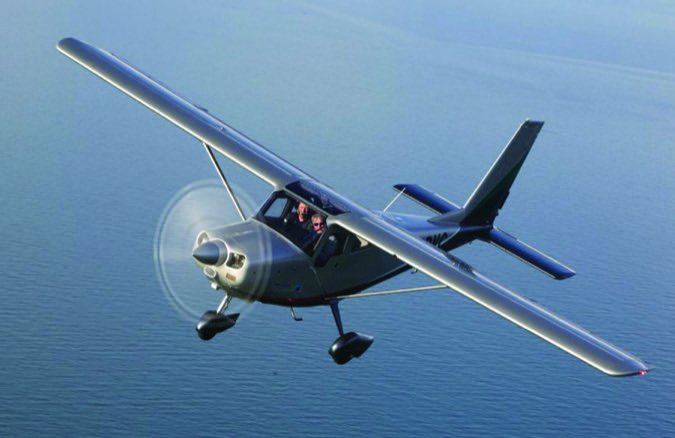
Vulcanair found some other designs and companies to buttress its business, including the SIAI Marchetti SF.600, a large utility-type twin aircraft that was eventually morphed into a single-engine version similar to the Cessna Caravan. Neither of these was ever put into series production.
However, the Partevania purchase got Vulcanair the rights to the P68, a Luigi Pascale-designed twin that found a market in the training and light transport segments. It’s powered by a pair of Lycoming IO-360s. Vulcanair lists six variants of the P68, including the P68R retractable and two Observer versions, one of which features a glazed nose for observation and patrol work. A stretch version of the aircraft, called the A-Viator, is powered by Rolls-Royce 250B turboprops and carries nine passengers and two crew. There are 49 P68s in service in the U.S., including three turboprop versions, according to the FAA registry.
The V1.0 is Vulcanair’s first foray into the single-engine trainer market, although it’s not entirely a clean-sheet design. Prior to being acquired by Vulcanair, Partenavia had developed an airframe called the P64 in two variants, the first dating to 1965. A bit more than 100 total were built and many are still flying in Europe.
The V1.0 is a developmental offshoot of the P64, but Mike McCann, marketing VP for Vulcanair’s U.S. marketing company, Ameravia, says it’s somewhere between a clean-sheet airplane and a revision of the original P64, which was also a high-wing strut-braced design, also with the third rear cabin door.
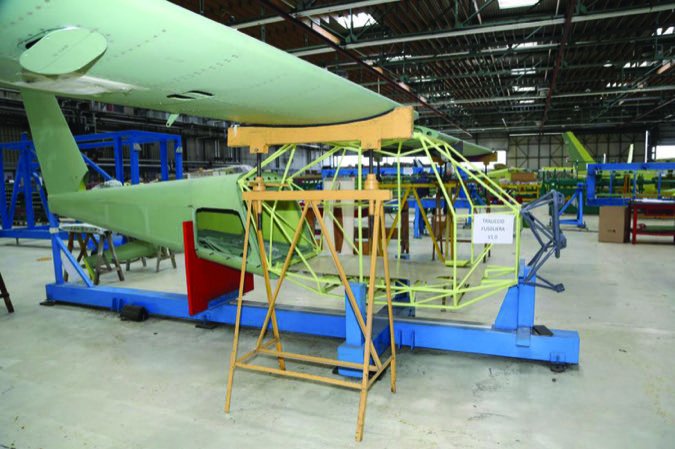
Pascale also designed two- and three-seat versions of the airplane called the P66B, C, D and T. These models saw higher production, totaling nearly 240 for all three models. The P66C was aerobatic and powered by a Lycoming O-320. All of these airplanes, including the V1.0, are on the same type certificate.
Tube and Sheet
The V1.0 is built similar to a Mooney, with a welded steel cage surrounding the main cabin married to a conventional aluminum riveted monocoque structure from the cabin aft. Like a Skyhawk, the wings are strut-braced, but the struts are aft of the main doors so ingress/egress is unimpeded.
The landing gear is spring aluminum passed through a heavy welded tubular box under the floorboards. Departing from the fashionable trend of castering nosewheels steered by differential braking, the V1.0 has an old-school steerable nosewheel. That’s probably a plus for flight schools, which otherwise burn through brake pads for students riding the pedals on the way to the runway.
While Cessna and most other high wings we’re familiar with have conventional horizontal stabilizers with elevators, the V1.0 sports a Piper-style stabilator with a tab for trim. Further departing from another trend-electric-only trim-the 1.0 has cable-driven manual-only trim. And that’s done by a big wheel poking up through the top of the center control console. It’s a welcome change from airplanes that rely only on yoke-mounted rockers for electric trim because it allows precise nudging to neutralize trim force, rather than the annoying too-fast-or-too-slow electric trim seems to deliver.
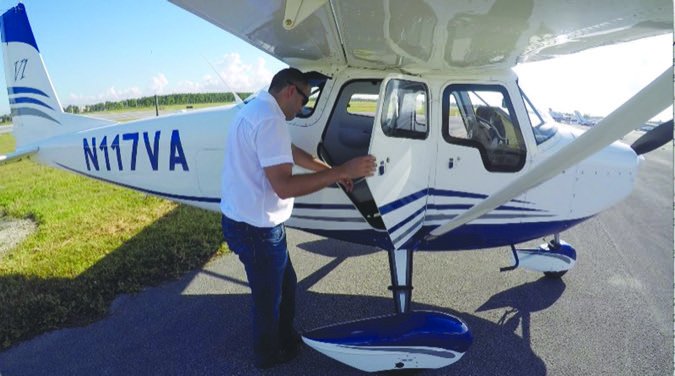
While on the topic of the trim, the center control console where it lives is one of the V1.0’s nicest design features, in my view. It sensibly contains the trim, throttle, prop and mixture controls in a single, well-designed structure that puts everything easily to hand. The pedestal also houses the alternate air control and on the floor below it, jacks for the headsets and the fuel control valve. Standard is a giant fire extinguisher under the pilot’s seat, also readily at hand. More airplanes would benefit from having that.
The interior is nothing fancy. There are thin floor coverings, but no upholstered side or door panels. In fact, the doors themselves are models of efficient production thinking. They’re light, single-piece composites with just enough hollow space to accommodate the latch mechanism. That interior space is accessed by a removable panel that serves as a combination armrest and closing handle. The doors fit we’ll and have a rubber gasket that seems to minimize noise and air infiltration.
Speaking of which, there are eyeball vents on the ceiling for ventilation for all four seats, but the only air conditioning option is to hold the two doors open. On a steamy Florida day in Miami, that was enough-just. But the cabin gets plenty of insolation because in addition to the door windows, there’s also a rear window and a skylight. While that makes for a bright cockpit, it also makes for a warm one.
Although the V1.0’s interior is utilitarian, it’s not entirely without minor luxuries. The rear seating area has easily accessible headset jacks and USB charging ports. The rear baggage area is accessible through a slot behind the rear seat. Baggage capacity is 88 pounds.
One thing that might need attention is the placement of the rudder pedals. When I flew with Chris Benaiges, CEO of Ameravia, he mentioned that tall people found them too high, causing their shins to strike the bottom lip of the panel. At 5 ft. 8 in., I didn’t have that problem, but figuring out how to plant my heels on the floor and still work the pedals and brakes took some accommodation. What it really needs is pedals that are a couple of inches shorter.
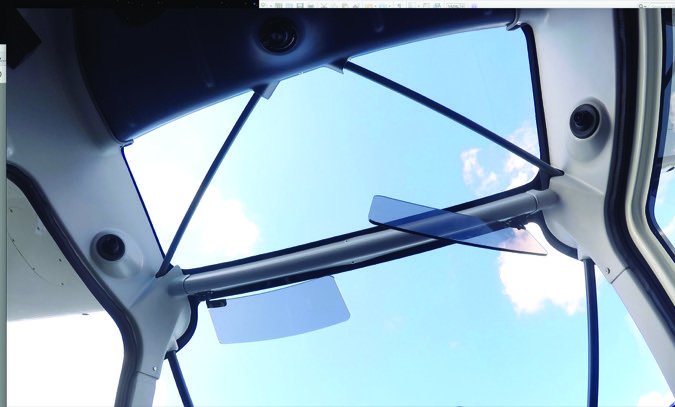
With the struts placed far aft, ingress and egress are unrestricted and there’s a tubular step forward of the door to assist. The seats have a reasonable range of sliding adjustment, which Benaiges told me will be increased to accommodate taller pilots. Access to the back seat is similarly unimpeded thanks to the rear door. But the door isn’t exactly large, so big people will find it a tight squeeze. And both front seats will need to be set forward if the rear passengers are to have any legroom. With a tall person in the left seat, the V1.0 is a three-person airplane, despite having reasonable useful load to carry four. If both front occupants are tall, the back seat won’t be as useful, unless the occupants are small.
Payload, Range, Performance
The V1.0 has about the useful load and payload you’d expect of a 180-HP airplane. On a gross weight of 2546 pounds-four pounds less than a Skyhawk-it has a useful load of 860 pounds on a typical empty weight of 1686 pounds. That’s functionally the same as a Cessna 172, although the V1.0 has a max landing weight of 2425 pounds, 121 pounds less than its gross. Given its structure, it’s not clear why this is necessary.
In the training role, with three people aboard, the V1.0 can be topped off. With four aboard, it can carry 30 gallons of avgas for a little over three hours of endurance. Max fuel is 50.2 gallons useful, stored in two welded aluminum wing tanks joined at the left/right (no both) fuel switch in the cockpit.
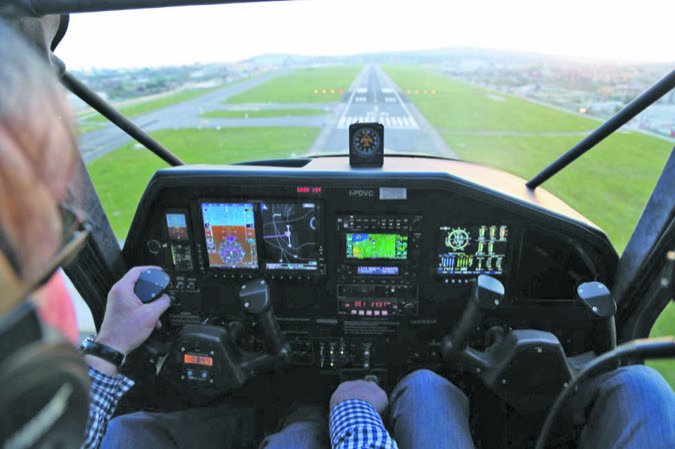
Although the CG envelope narrows at higher weights, at typical loads, it doesn’t take heroics to remain within it. With two people, full fuel and light bags, it’s mid-envelope. With four people and full fuel-30 gallons-it’s just at the northeast corner of the envelope, biased aft.
Unlike the Skyhawk, the V1.0 can operate in the utility category at all weights, although it’s not approved for any aerobatics, including spins. That could be a deal breaker for some schools that want the option of spin training for CFI applicants.
Whether by dint of the constant speed prop or a little less drag, the V1.0 is faster than the Skyhawk, at least on paper. Inexplicably, it’s thirstier. At about 65 percent power and 6000 feet, the Skyhawk will cruise at 114 knots on 9 GPH. Under the same conditions, the V1.0 turns in about 120 knots, but on 10.3 GPH. Throttled back to the same fuel burn as the Skyhawk, the V1.0 would cruise at about 112 knots.
The higher fuel burn dents the V1.0’s range a little. At the aforementioned power setting, the V1.0 is good for 494 miles in still air, with a 45-minute reserve, against 585 for the slower Skyhawk. On the equivalent 500-mile trip, the Vulcanair would arrive 12 minutes sooner.
Flight Impressions
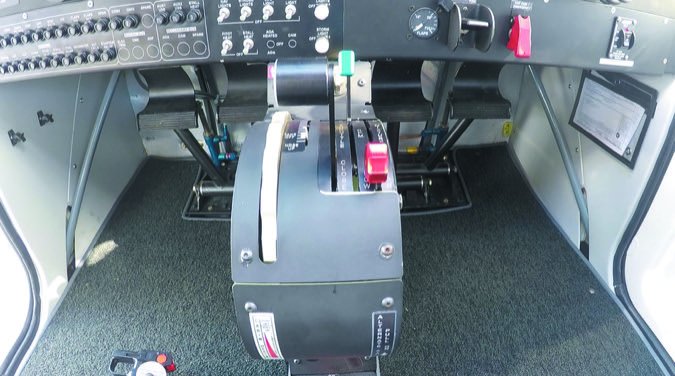
The V1.0 flies like it looks: solid, workmanlike and no surprises. The Lycoming IO-360 is a good choice for lacking a carburetor and for having the constant speed prop, which students will have to deal with eventually if they’re going on to professional flying careers.
In the interests of economy, Vulcanair chose Garmin’s G500 for the early airplanes, but going forward, the airplane will have the new TXi touchscreen displays, with a GTN 650 driving the nav and comm. In my view, this is another wise choice, for the G1000 NXi is both expensive and technological overkill for a basic trainer. Further, it doesn’t resemble the systems professional pilots will operate in jet transports, so what’s the point? The TXi displays are both highly capable and easy to operate, even if the V1.0 version lacks an autopilot.
Other than the rudder pedal foible, the airplane tracks we’ll during taxi but has a somewhat limited turning radius when hand maneuvered with the tow bar. The sight picture while taxiing and climbing is adequate, albeit limited over the nose when climbing at Vx or Vy. Initial climb rate on a hot day was 700 to 900 FPM.
Here, I’ll add my usual plaintive wish for a stick rather than yokes. The V1.0’s yoke is slightly too large for the size of the airplane, although it doesn’t obscure the main panel. Control forces are pleasant, if a bit heavy in pitch, probably due to the stabilator. Steep turns require either nose-up trim or an increasingly firm pitch pull.
I can’t remember the last time I encountered a modern FAR Part 23 airplane with handling or stall surprises and the V1.0 has neither. It’s crazy stable in pitch. When I disturbed it to provoke a phugoid, it returned to trim pitch and speed in a cycle-and-a-half. In roll, it departs more vigorously if left to its own devices from a 20-degree banked turn.
Stalls are benign, but it does take a determined pull to get the last bit of yoke travel to get anything like break. The yoke rises noticeably during that last bit of travel. It has a gentle parachute mode with no tendency toward a sharp break or a shear off into a spin. Flap deployment causes little pitching moment. The flap control, by the way, lacks presets, so there’s an indicator to set it for takeoff (14 degrees) and the full 42 degrees for landing. This would be easy to add, but I’m not sure it’s necessary. In passing, I wouldn’t mind if the white arc was a little wider. Max flap extension speed is 78 knots indicated.
Conclusion
At $278,000 base, variable by the Euro exchange rate, the V1.0 compares favorably to the Skyhawk on price. In fact, it crushes it. But for big schools, aircraft purchases aren’t just about price. They’re also looking for dispatch reliability and a support structure to match. Cessna and Piper have proven good at that, at least in the U.S.
The V1.0 appears less economical than the Skyhawk or the Piper Archer, but whether that washes out the $100,000-plus price delta for schools is an unknown. It might for some and not others.
Although Vulcanair is not pushing sales into the private owner market and Cessna doesn’t appear to be either, there’s no apparent reason the 1.0 wouldn’t be the equal of a Skyhawk for personal use. It’s a little faster and the third door is a nice add-on.
In my view, if Vulcanair wants to make a dent with this airplane, it will need to build out an aggressive sales and support structure in the U.S. If the company can fly a would-be fleet buyer into Miami-where the U.S. arm is based-and walk through a modern parts warehouse and a modest call center, I suspect that lower price will suddenly look a lot better.
For more information, see www.ameraviainc.com or contact Mike McCann at 818-307-5607.


